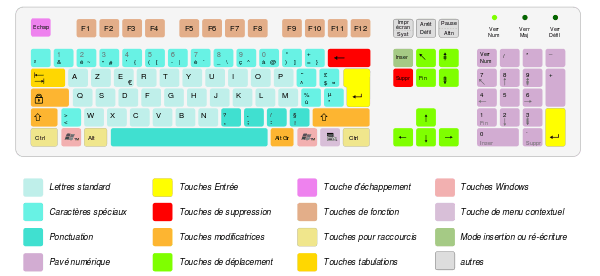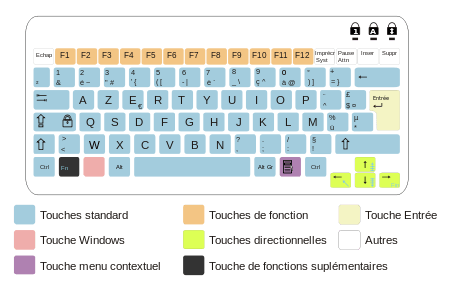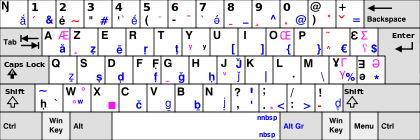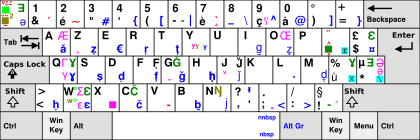AZERTY

AZERTY /əˈzɜːrti/ is a specific layout for the characters of the Latin alphabet on typewriter keys and computer keyboards. The layout takes its name from the first six letters to appear on the first row of alphabetical keys. Like the German QWERTZ layout, it is modelled on the English QWERTY layout. It is used by most French speakers based in Europe, though France and Belgium each have their own national variations on the layout. Luxembourg and Switzerland use the Swiss QWERTZ keyboard. Most of the residents of Quebec, the mainly French-speaking province of Canada, use a QWERTY keyboard that has been adapted to the French language, although the government of Quebec and the Government of Canada stipulate and use the Multilingual Standard keyboard CAN/CSA Z243.200-92.[1][2][3]
The competing layouts devised for French (the ZHJAYSCPG layout put forward in 1907, Claude Marsan's 1976 layout, the 2002 Dvorak-fr and the 2005 Bépo layout) have won only limited recognition.
History
The AZERTY layout appeared in France in the last decade of the 19th century as a variation on American QWERTY typewriters. Its exact origin is unknown. At the start of the 20th century, the French “ZHJAY” layout, created by Albert Navarre, failed to break into the market for the simple reason that secretaries were already accustomed to the QWERTY and AZERTY layouts.[4][5]

In France the AZERTY layout is the de facto norm for keyboards. Nowhere does this layout feature as an officially recognized French standard. However, in 1976, a QWERTY layout adapted to the French language was put forward as an experimental standard (NF XP E55-060) by the French national organization for standardization. This standard made provision for a temporary adaptation period during which the letters A, Q, Z and W could be positioned as in the traditional AZERTY layout. No provision, though, was made for adapting the M key, even on a temporary basis. As of January 2016 the French Culture Ministry is looking to replace the AZERTY layout with one that will decrease the chance of typing mistakes.[6]
The AZERTY layout is used on Belgian keyboards (although some non-alphabetic symbols are positioned differently) and is also the inspiration behind the Lithuanian ĄŽERTY layout.
General information regarding AZERTY keyboards


Several details should be noted:
- the Alt Gr key allows the user to type the character shown at the bottom right of any key with three characters.
- the Alt key is used as a shortcut to commands affecting windows, and is also used in conjunction with ASCII codes for typing special characters.
Dead keys
A dead key serves to modify the appearance of the next character to be typed on the keyboard. Dead keys are mainly used to generate accents (or diacritics) on vowels.
Circumflex accent
A circumflex accent can be generated by first striking the ^ key (located to the right of P in most AZERTY layouts), then the vowel requiring the accent (with the exception of y). For example, pressing '^' then 'a' produces 'â'.
Diaeresis
A diaeresis can be generated by striking the ¨ key (in most AZERTY layouts, it is generated by combining the Maj + ^ keys), then the vowel requiring the accent. For example, pressing '¨' then 'a' produces 'ä'.
Grave accent
The grave accent can be generated by striking the ` key (in the French AZERTY layout it is located to the right of the “ù” key on Macintosh keyboards, while on PC-type keyboards it can be generated by using the combination Alt Gr + è.
In the Belgian AZERTY layout, the ` key is generated by the combination Alt Gr + µ; the µ key is located to the right of the ù key on Belgian AZERTY keyboards) then the key for the vowel requiring the accent.
Note that the grave-accented letters à è ù (and the acute-accented é), which are part of French orthography, have their own separate keys. Dead-grave and dead-acute (and dead-tilde) would mostly be reserved to "foreign" letters such as Italian ò, Spanish á í ó ú ñ, Portuguese ã õ, etc., or for accented capital letters (which are not present precomposed in the layout).
Acute accent
The acute accent is available under Windows by the use of Alt + a, then the vowel requiring the accent. For Linux users, it can be generated using Caps Lock + é then the vowel. On a Macintosh AZERTY keyboard, the acute accent is generated by a combination of the Alt + Maj + &, keys, followed by the vowel.
In the Belgian AZERTY layout, it can be generated by a combination of Alt Gr + ù, then the vowel.
Tilde
The tilde is available under Windows by using a combination of the Alt Gr + é keys, followed by the letter requiring the tilde.
In the Belgian AZERTY layout, it can be generated by a combination of Alt Gr + =.
Alt key
With some operating systems, the Alt key generates characters by means of their individual codes. In order to obtain characters, the Alt key must be pressed and held down while typing the relevant code into the numeric keypad.
On Linux, the alt key gives direct access to French language special characters. The ligatures œ and æ can be keyed in by using either Alt Gr + o or Alt Gr + a respectively, in the fr-oss keyboard layout; their upper case equivalents can be generated using the same key combinations plus the French Shift key. Other useful punctuation symbols, such as ≤, ≥, or ≠ can be more easily accessed in the same way.
Guillemets "«" and "»"
Also called angle quotes, French quotation marks, double chevrons are polylines pointed like arrows (« or »), sometimes forming a complementary set of punctuation marks used as a form of quotation mark.
| « | Alt + 0171 | Alt + 7598 | Alt + 174 | Alt + 686 |
|---|---|---|---|---|
| » | Alt + 0187 | Alt + 7599 | Alt + 175 | Alt + 687 |
With a US International Keyboard and corresponding layout, Alt Gr+[ and Alt Gr+] can also be used. The characters are standard on French Canadian keyboards and some others.
Macintosh users can type "«" as ⌥ Opt+\ and "»" as ⌥ Opt+⇧ Shift+\. (This applies to all English-language keyboard layouts supplied with the operating system, e.g. "Australian", "British", "Canadian", "Irish", "Irish Extended", "U.S." and "U.S. Extended". Other language layouts may differ). In French-language keyboard layouts ⌥ Opt+7 and ⌥ Opt+⇧ Shift+7 can be used. On Norwegian keyboards, ⌥ Opt+⇧ Shift+v for "«", and ⌥ Opt+⇧ Shift+b for "»", can be used.
For users of Unix-like operating systems running the X Window System, creation of the guillemet depends on a number of factors including the keyboard layout that is in effect. For example, with US International Keyboard layout selected a user would type Alt Gr+[ for "«" and Alt Gr+] for "»". On some configurations they can be written by typing "«" as Alt Gr+z and "»" as Alt Gr+x. With the compose key, press Compose+<+< and Compose+>+>. Additionally with the ibus input method framework enabled, users may enter these characters into those applications that accept it by using Ctrl+⇧ Shift+U followed by their Unicode code points: either AB or BB, respectively.
In Microsoft Office applications, typing the US quotation mark (on the 3 key) will produce either a left Guillemet "«" or right Guillemet "»" based on the spacing.
In France
AZERTY under Linux
In X11, the window system common to many flavors of UNIX, the keyboard interface is completely configurable allowing each user to assign different functions to each key in line with their personal preferences. For example, specific combinations of Alt Gr + key could be assigned to many other characters.
Layout of the French keyboard under Microsoft Windows
Missing elements
- Ever since the AZERTY keyboard was devised, a single key has been dedicated to the letter (ù), which occurs in only one word (où [where]); the œ is completely unrepresented, despite the fact that it is an integral part of the French language and occurs in many different words.
- æ, as in Lætitia [girl's name] or ex æquo [dead-heat].
- The non-breaking space, which prevents having punctuation characters in isolation at the ends or beginnings of lines.
- Guillemets – French language opening and closing quotation marks, « and ».
- The capital letters, É, Ç, Œ … (in the word Œdipe [Oedipus], for example), are available neither on the typewriter itself, nor using the operating system mentioned earlier.
It is possible to fill in these gaps by installing a keyboard driver that has been specially enriched for the French language.[7]
Some word-processing software packages sometimes address some of these gaps. The non-breaking space can be obtained by pressing the Ctrl key, followed by a space, in a word-processing package such as OpenOffice.org Writer, or by using Ctrl + Maj [Caps] + Espace [Spacebar] in Microsoft Word.
Apart from these gaps, the French AZERTY layout has some strange features which are still present in the Microsoft Windows Vista operating system:
- The combination Maj + ² does not generate any character at all.
- The presence of two "^" (one of which is a dead key and is located at the right of the "p", while the other – on the ç9 key — is not).
- When a ¦ is required, a | is generated.
- Typing a period or numerals requires pressing Shift, whereas some rarer characters (ù, the semicolon) do not. This has led to drives to reform the AZERTY keyboard (chiefly by doing away with the ù, which may be typed using AltGr+è and u anyway, and/or swapping the period and semicolon), although to date this has not been successful.
Government criticism
As of January 2016 the French Culture Ministry is looking to replace the AZERTY layout with one that will decrease the chance of typing mistakes.[6][8]
Differences between the Belgian and French layouts of the AZERTY keyboard



The Belgian AZERTY keyboard allows for the placing of accents on vowels without recourse to encoding via the Alt key + code. This is made possible by the provision of dead keys for each type of accent: ^ ¨ ´ ` (the last two being generated by a combination of Alt Gr + ù and µ respectively).
To recap the list of different keys from left to right and from top to bottom:
- First row (symbols and numbers):
- By combining the shift and ² keys, ³ is obtained;
- The symbol |, is generated by a combination of Alt Gr + & same key as the 1;
- The @ symbol is generated by a combination of Alt Gr + é same key as the 2;
- Unlike the French layout, the ' key (or 4 key) does not contain a third symbol;
- Unlike the French layout, the ( key (or 5 key) does not contain a third symbol;
- The ^ symbol is generated by a combination of Alt Gr + § same key as the 6 ; but, as opposed to the ^ symbol found to the right of the p key, it is not a dead key, and therefore does not generate the placing of a circumflex accent;
- Unlike the French layout, the è (or 7) key does not contain a third symbol;
- Unlike the French layout, the ! (or 8) key does not contain a third symbol;
- The { symbol is obtained by a combination of Alt Gr + ç same key as the 9;
- The } symbol is obtained by a combination of Alt Gr + à same key as the 0;
- Unlike the French layout, the ) (or °) key does not contain a third symbol;
- The key to the right of the ) key contains the following symbols: - _ with shift and, unlike the French layout, does not contain a third symbol.
- Second row (the letters AZERTYuiop):
- the alphabetical keys do not have Alt Gr codes apart from the e, which generates the euro symbol, €;
- The [ symbol is obtained by a combination of Alt Gr + ^ same key as the ¨ (a partially dead key located to the right of the p key);
- the key to the right of the ^ key contains the following symbols: $ * with shift and ] with Alt Gr;
- Third row (the letters qsdfghjklm)
- the key to the right of m contains the following symbols: ù % with shift and the partially dead key ´ with Alt Gr, which allows acute accents to be generated on accented vowels;
- the key to the right of ù contains the following symbols: µ £ with shift and the partially dead key ` with Alt Gr, which allows grave accents to be generated on accented vowels;
- Fourth row (the letters wxcvbn and basic punctuation):
- The \ symbol is generated by a combination of Alt Gr + <;
- the key to the right of : contains the following symbols: = + with shift and the partially dead key ~ with Alt Gr, the latter either generating the tilde symbol when combined with the space bar, or positioning a tilde over a letter: a → ã, A → Ã, n → ñ, N → Ñ, o → õ, O → Õ.
The description partially dead means that pressing the key in question sometimes generates the desired symbol directly, but that at least one of the symbols represented on the key will only appear after a second key has been pressed. In order to obtain a symbol in isolation, the space bar must be pressed, otherwise a vowel should be pressed to generate the required accented form.
The other keys are identical, even though traditionally the names of special keys are printed on them in English. This is because Belgium is predominantly bilingual (French-Dutch) and officially trilingual (a third language, German, is spoken in the East Cantons).
It should be noted that the key to the right of 0 on the numeric keypad corresponds either to the full stop or to the comma (which is why there are two dinstinct keyboard drivers under Windows).
The AZERTY keyboard as used in the Dutch speaking part of Belgium uses shift instead of maj and caps lock instead of verr maj.
Variants
The AZERTY layout is used in France, Belgium and some African countries. It differs from the QWERTY layout thus:
- A and Q are swapped,
- Z and W are swapped,
- M is moved to the right of L (where colon/semicolon is on a US keyboard),
- The digits 0 to 9 are on the same keys, but to be typed the shift key must be pressed. The unshifted positions are used for accented characters,
- Caps lock is replaced by Shift lock, thus affecting non-letter keys as well. However, there is an ongoing evolution towards a Caps lock key instead of a Shift lock.
The French and Belgian AZERTY keyboards also have special characters used in the French language, such as ç, à, é and è, and other characters such as &, ", ' and §, all located under the numbers.
French

Some French people use the Canadian Multilingual standard keyboard.
The Portuguese (Portugal) keyboard layout may also be preferred, as it provides all the French accents (acute, grave, diaeresis, circumflex, cedilla, including on capital letters that are not all possible with a basic French standard layout, and also the French quotation marks or guillemets, «»). Furthermore, its dead-letter option for all the accent keys allows for easy input of all the possibilities in French and many other languages (áàäãâéèëêíìïîóòöõôúùüû). 'ç' is, however, a separate key (but only as a lowercase letter in the basic French standard layout).
The US-International keyboard may also used for the same reason (notably by programmers as it allows easier input of ASCII characters, provided that they are trained to a QWERTY layout rather than the most common AZERTY layouts available in most computer shops, including online). An alternative (extremely rarely found) to AZERTY is the BÉPO layout : it's not available on any notebook, but may be used by adding an external keyboard, bought separately from some specialized shops.
However the most common layouts available as an option in computer shops and that are not using the standard French layout is still the basic US layout, plus the QWERTY-based layouts used for Chinese and Vietnamese (that you can find in Parisian shops where there's a large enough Asian community, many of these shops being owned by people of Chinese or South-East Asian origin), or Arabic. Computer providers have also sold computers with the Belgian French AZERTY layout to French universities and schools. Most standard national layouts used in the world, and all layouts used in the European Union can easily be bought in online shops within the European Union as the old standard French keyboard is no longer mandatory.
Apple
Apple's keyboards use the same AZERTY layout in both France and Belgium.[9] Based on the Belgian version, the most notable differences are the locations for the @-sign and €-sign, among others. OS X also supports the standard French layout for non-Apple keyboards; the standard Belgian layout, however, is available through third-party support only.[10]
Tamazight (Berber)

The Tamazight (Latin) standards-compliant layout is optimised for a wide range of Tamazight (Berber) language variants – including Tuareg variants – rather than French, though French can still be typed quickly. It installs as "Tamazight_L" and can be used both on the French locale and with Tamazight locales.
QWERTY and QWERTZ adaptations of the layout are available for the physical keyboards used by major Amazigh (Berber) communities around the world.

Other layouts exist for closer backwards compatibility with the French layout. They are non-standards-compliant but convenient, allowing typing in Tifinagh script without switching layout:
- Tamazight (International) extends the French layout with Tamazight (Berber), and offers secondary Tifinagh script access by deadkey. It installs as "Tamazight (Agraghlan)" or "Français+" and is available from the official site of the Algerian High Council for Amazighity (HCA).
- Tamazight (International)+ is optimised for Tamazight (Berber), but retains close French compatibility and provides easy typing in Tifinagh script by Caps Lock. It installs as "Tamazight (Agraghlan)+" or "Tamazight_LF".
All the above layouts were designed by the Universal Amazigh Keyboard Project and are available from there.[11]
See also
References
- ↑ Office québécois de la langue française, Le clavier de votre ordinateur est-il normalisé?.
- ↑ Services gouvernementaux du Québec, Standard sur le clavier québécois.
- ↑ Alain LaBonté, 2001, FAQ. La démystification du clavier québécois (norme CAN/CSA Z243.200-92)
- ↑ Martin, Henri-Jean (1995). The history and power of writing. University of Chicago Press. p. 608. ISBN 0-226-50836-6.
- ↑ Gardey, Delphine. "La standardisation d'une pratique technique: la dactylographie (1883–1930)". Réseaux. 16 (87).
- 1 2 "France wants to fix the terrible AZERTY keyboard". Engadget. Retrieved 2016-01-26.
- ↑ Denis Liégeois, pilote de clavier azerty enrichi pour Windows.
- ↑ http://www.bbc.co.uk/news/blogs-eu-35365604
- ↑ "How to identify keyboard localizations". Apple Inc. Retrieved 2015-04-22.
- ↑ "Belgian (Non-Apple) Keyboard Layout". El Tramo. Retrieved 2013-11-16.
- ↑ "SourceForge.net: Anasiw amaziɣ ameɣradan – Project Web Hosting – Open Source Software". sourceforge.net.
External links
| Wikimedia Commons has media related to AZERTY keyboard layouts. |
- The typewriter on the site of the National Archives
- Accentuate the capital letters
- The page on the Microsoft keyboard layouts / keyboard layouts